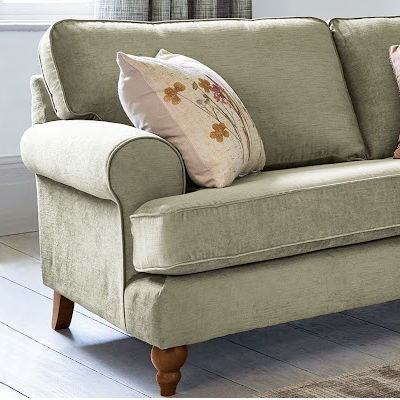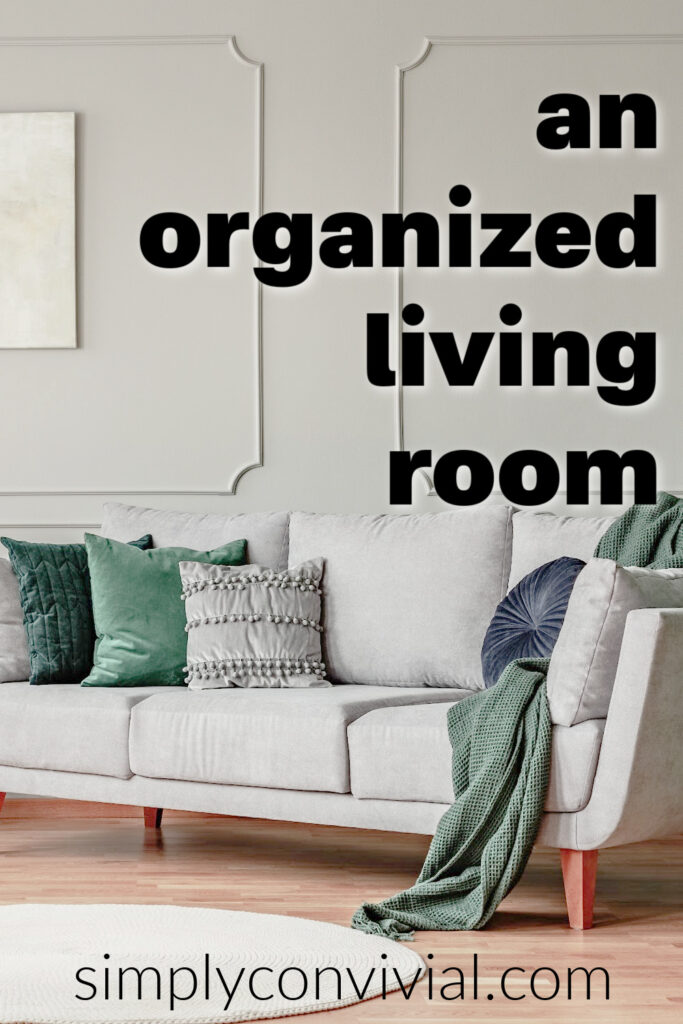The living room is aptly named. It is a room for living, not for showing off. In the living room we read, talk, and form connections with one another and friends. We study, work, and relax. The living room is for conversations and cuddles.
The entryway, on the other hand, is for coming and going. It’s a place of transitions. Yet, it’s often a part of or attached to the living room space. Sometimes a part of the living room must even function as the entry. So we’re going to tackle them together because places of transition are usually also places of clutter.
What is the purpose of a living room?
If a living room is where we live together and relax, we have to adjust our approach accordingly. If we put time in cleaning, organizing, and decorating, the point of that effort isn’t to turn it into a showroom.
We don’t want the parlor effect, where we set up a room “just so” for company and then get mad at our husbands and children for messing it up because they had the nerve to actually live in the living room.
I like to think of the whole house, but particularly the living and dining rooms as a stage. In the production of a play, the stage is never the point or the star. The stage is set for the actors to do their thing. The stage can accent and facilitate the story or it can get in the way and interfere with the action.
Better to have a bland, vanilla stage where the actors can act than a stage cluttered up hampering all movement.
Better, too, to have a bland, vanilla stage than a stage that tries to upstage the action, that outshines the story, and distracts from the production because it’s just too perfect or too much. Worse, consider how awkward it would be if the stage hands and director started shouting from off-set at the actors if they jostled anything on the pristine stage?
That’s not what we want to be.
How clean should your living room be?
If we think of our living room more like a stage for our family’s story to play out on, then we have a different kind of standard for and approach to cleaning.
A stage has to be cleared and changed between sets. Between productions, the stage is reset for next time. So it is with us, our house, and our days. Each day is a production. At a few key transition times – entré acts, perhaps – the stage might need some quick attention. At the end of the day, it needs to be brought back to neutral, cleared and prepped for the next day’s action, not for a photo shoot.
With this mindset, we are able to appreciate the reality that our homes are places of action and not still lives or dollhouses we micromanage.
Is your living room and entryway functional?
So if your living room is a stage, then let’s examine it to see how well it’s functioning.
Start by asking yourself – What do you love about your entry and living room?
It’s so easy to start cleaning and organizing from a place of grumbling and critique rather than gratitude. But trash talking yourself, your space, or your family is not going to help you in any way. On the other hand, gratitude actually motivates and enlivens cheerful action.
After considering what’s good about your current layout and setup, you are then ready to examine obstacles and difficulties. What feels like it’s getting in the way in your entry and living room?
When considering what’s not working and what is in your space, then you can begin to troubleshoot potential solutions. What would make your entry and living room feel more welcoming and functional?
After all, welcoming people and making conversation comfortable is part of the living room’s job, so it’s not like functional means bare-bones. We just need to remember that the setting is to serve the people, not the other way around.
How to clean your living room
Once we’ve adjusted our mindset and thought through our particular situation’s current needs, we’re ready to tackle some basic baby-step chores that will have an outsized effect on our living room space.
First, tidy up all out of place outerwear. Particularly if your entry joins your living room space, you likely have coats and shoes pile up. Instead of spinning your mental and emotional wheels over how to make it stop happening, just focus on what is in front of you right now. Put things away where they belong. Line up the shoes. Hang the coats. Toss kids’ socks in the hamper.
Don’t think up strategies to prevent your kids from draping coats on the chair and dumping backpacks on the couch. Instead, spend 5 minutes just putting away things that are out.
Next, clear all surfaces meant to be seating. Spruce up those spaces. In our kitchen we set up our island of sanity, where we always start cleaning and do our best to keep clear of clutter accumulation. The living room has its own version, but it is to keep chairs, couches, and other seat-like surfaces available for actual sitting rather than temporary dumping grounds.
The clutter will accumulate, like magnets to metal, to any and all convenient horizontal spaces. Instead of fussing about it or trying to brainstorm ways to prevent it, we can just take care of it. Direct your attention here first whenever you’re tidying the living room. Soon it will be a natural action and everyone will benefit from having actual functional furniture.
Our final baby step for traction and momentum in the living room is to add or improve a container in your entry for items that collect and are prone to getting lost.
Clutter will collect. We don’t have to fight it. Instead, we can simply take care of it regularly. In fact, dealing with stuff is a huge part of home management and homemaking. It’s ok. It’s the job. We don’t have to work ourselves out of a job; we just need to do our job.
One way to cut down on the clutter is to give a designated home to small items that are frequently needed and frequently misplaced or hidden. It can be as simple as a magazine holder for mail.
Now, certainly there are more steps you might take. We haven’t vacuumed, washed windows, or done anything too drastic. However, we have dealt with the common irritants that most often inhibit the living room from doing its job. That’s always where we should begin. Then, if that’s as far as we get, it’s ok because the space is functional and the living, not the arrangement or appearance, is the point.
Living room speed cleaning routine
The living room is one of the easiest areas to clean quickly, as long as it’s not hosting too many piles. Piles take up space meant for people. If you have a lot of clutter in your living room or entry way, work on spending 10 minutes a day (with a timer!) giving things homes and getting rid of stuff no one in your house needs or wants.
Even if you have clutter you’ll be working on – and especially if you don’t – a quick 15 minute cleaning sprint makes a huge difference in the living area:
- Spend 5 minutes neatening piles, tossing garbage, and wiping down dust.
- Spend 5 minutes removing homeless items from the entryway and living room.
- Spend 5 minutes adding a welcoming touch of beauty.
Love your home’s living room space
Identify a common complaint you have about your entry and living room. Replace that complaint with a written, related statement of gratitude.
Spend a full minute, with a timer, thanking God for the things you love about your entry and living room.
Which horizontal space is your biggest hot spot for clutter? Spend 5 minutes decluttering and tidying that spot at least 3 times a week. Spend only 5 minutes, whether or not you’re “done.”
Keep up with Organize October!
Week 2 of Organize October is all about decluttering your living room and entryway. Get the checklist, opportunities for prizes, and links to meetups and workshops by signing up for this free challenge! It’s not too late to get started and you don’t have to catch up to start week 2 progress.

